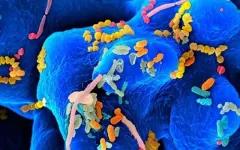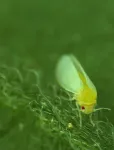INFORMATION:
Other UT Dallas contributors were co-lead author Deepak Monga, a mechanical engineering doctoral student, and Dr. Lei Zhang, a postdoctoral researcher in mechanical engineering.
The research was funded by the National Science Foundation and the Army Research Office.
'Climbing droplets' could lead to more efficient water harvesting
UT Dallas researchers' novel surface encourages droplets to move spontaneously into larger droplets
2021-03-25
(Press-News.org) University of Texas at Dallas researchers have discovered that a novel surface they developed to harvest water from the air encourages tiny water droplets to move spontaneously into larger droplets.
When researchers placed microdroplets of water on their liquid-lubricant surface, the microdroplets propelled themselves to climb, without external force, into larger droplets along an oily, ramp-shaped meniscus that forms from the lubricant around the larger droplets. The "coarsening droplet phenomenon" formed droplets large enough for harvesting.
"This meniscus-mediated climbing effect enabled rapid coalescence on hydrophilic surfaces and has not been reported before. We have discovered a new physical phenomenon that makes it possible to harvest water more rapidly from air without external force," said Dr. Xianming Dai, assistant professor of mechanical engineering in the Erik Jonsson School of Engineering and Computer Science, who led the work. "If we don't have this new phenomenon, the droplets would be too small, and we could hardly collect them."
Microdroplets of water on a hydrophilic SLIPS surface (left) propel themselves to climb, without external force, into larger droplets along an oily, ramp-shaped meniscus that forms from the lubricant around the larger droplets. On the right, the video clip shows how microdroplets behave on a solid slippery surface.
The findings, published March 25 in Cell Reports Physical Science, could solve key problems in harvesting water from air. Many droplets that condense from water vapor in the air are too small to be collected, and they can cover a surface in a way that impedes further condensation.
Developing new technologies that harvest water from the atmosphere is a growing field of research as more and more people live in areas where fresh water is in short supply. Scientists estimate that 4 billion people live in regions with severe freshwater shortages for at least one month each year. This number is predicted to rise to between 4.8 billion and 5.7 billion by 2050. Reasons include climate change, polluted water supplies and increased demand due to both population growth and changes in usage behavior.
The key to the microdroplet's self-climbing action is a surface that Dai and his colleagues previously developed. Their liquid lubricant, a hydrophilic slippery liquid-infused porous surface (SLIPS), has a unique hydrophilic nature for water harvesting and rapidly directs water droplets into reservoirs.
Researchers discovered the self-propelling droplet phenomenon on their surface by accident. They were testing different lubricants to determine which could best facilitate water harvesting when they saw the smaller water droplets propel themselves into larger droplets. That led them to collaborate with Dr. Howard A. Stone, chair of mechanical and aerospace engineering at Princeton University and an expert in fluid dynamics, to investigate the underlying physics of the phenomenon.
"Dr. Dai and his team led this work. The ideas are creative, and they made a series of observations in the laboratory that allowed them to understand the underlying physics and its potential applications," Stone said. "They reached out to me to discuss the mechanism, and we had several Skype or Zoom meetings and email exchanges. It was all very interesting and stimulating. I enjoyed very much seeing the ideas evolve into the published paper."
As water vapor condenses on the liquid-lubricant surface, oil from the lubricant forms a meniscus, or curvature, around the droplets. The meniscus looks like an upward-curving ramp, which acts like a bridge along which microdroplets spontaneously climb toward and coalesce with larger water droplets, a process the researchers call the coarsening effect. The properties of the lubricated surface prevent the water droplets from being completely submerged in the oil, so they can float on the oil, allowing them to climb.
"The oil meniscus acts like a bridge, so the droplet can climb on it," Dai said. "The small droplet actively looks for a larger one. After they are connected by the bridge, they become one."
As tiny water droplets condense from air on a cooled surface, they become thermal barriers that prevent further condensation. By allowing for rapid water droplet collection, the coarsening droplets help clear surfaces for new droplets to form, which facilitates faster, more efficient water harvesting.
The self-propelled coarsening droplet on hydrophilic SLIPS shows rapid removal of condensed submicrometer-sized droplets regardless of how the surface is oriented, which presents a promising approach compared to other surfaces used for water harvesting.
"We cannot harvest a large amount of water unless we have a rapid harvesting process. The problem with other surfaces is that the small water droplets may evaporate before they can be harvested," Dai said.
"Based on our experimental data, the coarsening surface enhanced the water harvesting rate 200% higher than its counterparts," said Zongqi Guo, a mechanical engineering doctoral student and co-lead author.
Dai and his colleagues continue to work on ways to use their lubricant to make sustainable water harvesting systems that are mobile, smaller in size, lower in weight and less expensive.
"If we can do that, we can harvest water anywhere that has air, which is particularly important in regions where water is scarce," Dai said.
ELSE PRESS RELEASES FROM THIS DATE:
Wisdom, loneliness and your intestinal multitude
2021-03-25
The evolving science of wisdom rests on the idea that wisdom's defined traits correspond to distinct regions of the brain, and that greater wisdom translates into greater happiness and life satisfaction while being less wise results in opposite, negative consequences.
Scientists have found in multiple studies that persons deemed to be wiser are less prone to feel lonely while those who are lonelier also tend to be less wise. In a new study, published in the March 25, 2021 issue of the journal Frontiers in Psychiatry, researchers at University of California San Diego School of Medicine take the connection between wisdom, loneliness ...
Study maps key proteins linked to epilepsy, revealing new drug targets
2021-03-25
An analysis of adult human brain tissue reveals over 900 proteins tied to epilepsy. The brain disorder, estimated to afflict more than 3 million Americans, is mostly known for symptoms of hallucinations, dreamlike states, and uncontrolled, often disabling bodily seizures.
Led by researchers at NYU Grossman School of Medicine, the study examined molecular differences among the brains of 14 epilepsy patients and another group of 14 adults of similar age and gender who did not have the disease.
Study results showed that altered levels of brain proteins predominated in the hippocampus, a structure located deep inside ...
Protein fingerprinting in minutes
2021-03-25
Researchers from Charité - Universitätsmedizin Berlin and the Francis Crick Institute have developed a mass spectrometry-based technique capable of measuring samples containing thousands of proteins within just a few minutes. It is faster and cheaper than a conventional blood count. To demonstrate the technique's potential, the researchers used blood plasma collected from COVID-19 patients. Using the new technology, they identified eleven previously unknown proteins which are markers of disease severity. The work has been published in Nature Biotechnology*.
Thousands of proteins are active inside the human body at any given time, providing its structure and enabling reactions which are essential to life. The body raises and lowers the activity ...
Exposure to flame retardants early in pregnancy linked to premature birth
2021-03-25
Expectant women are more likely to give birth early if they have high blood levels of a chemical used in flame retardants compared with those who have limited exposure, a new study finds.
These polybrominated diphenyl ethers (PBDEs) are used in the manufacture of furniture, carpeting, and other products to reduce flammability. Previous studies have found that the substances can leach into household dust and build up in the body where they may interfere with the thyroid, an organ that secretes brain-developing hormones. Childhood exposure to PBDEs has been linked to learning disabilities, autistic ...
Plant gene found in insect, shields it from leaf toxins
2021-03-25
Millions of years ago, aphid-like insects called whiteflies incorporated a portion of DNA from plants into their genome. A Chinese research team, publishing March 25th in the journal Cell, reveals that whiteflies use this stolen gene to degrade common toxins plants use to defend themselves against insects, allowing the whitefly to feed on the plants safely.
"This seems to be the first recorded example of the horizontal gene transfer of a functional gene from a plant into an insect," says co-author Ted Turlings (@FARCE_lab), a chemical ecologist and entomologist ...
Octopuses have two alternating sleep states, study shows
2021-03-25
Octopuses are known to sleep and to change color while they do it. Now, a study publishing March 25 in the journal iScience finds that these color changes are characteristic of two major alternating sleep states: an "active sleep" stage and a "quiet sleep" stage. The researchers say that the findings have implications for the evolution of sleep and might indicate that it's possible for octopuses to experience something akin to dreams.
Scientists used to think that only mammals and birds had two sleep states. More recently, it was shown that some reptiles also show non-REM and REM sleep. A REM-like sleep state was reported ...
Text message program shows 60 percent of opioid tablets unused after common procedures
2021-03-25
More than half of the opioid tablets prescribed for patients who underwent orthopaedic or urologic procedures went unused in a new study by researchers at the Perelman School of Medicine at the University of Pennsylvania. Using an automated text messaging system that regularly checked in with patients on their pain and opioid use, the study also showed that most opioids are taken within the first few days following a procedure and may not be necessary to manage pain even just a week following a procedure. The study was published today in JAMA Network Open.
"Through simple text messaging we highlight a method which gives clinicians the information they need to reduce prescribing and manage ...
Pregnant women show robust immune response to COVID vaccines, pass antibodies to newborns
2021-03-25
BOSTON - In the largest study of its kind to date, researchers at Massachusetts General Hospital, Brigham and Women's Hospital and the Ragon Institute of MGH, MIT and Harvard have found the new mRNA COVID-19 vaccines to be highly effective in producing antibodies against the SARS-CoV-2 virus in pregnant and lactating women. They also demonstrated the vaccines confer protective immunity to newborns through breastmilk and the placenta.
The study, published in the American Journal of Obstetrics and Gynecology (AJOG), looked at 131 women of reproductive age (84 pregnant, 31 lactating and 16 non-pregnant), ...
Forty-three percent of melanoma patients have chronic complications from immunotherapies
2021-03-25
Chronic side effects among melanoma survivors after treatment with anti-PD-1 immunotherapies are more common than previously recognized, according to a study published March 25 in JAMA Oncology.
The chronic complications, which occurred in 43% of patients, affected the joints and endocrine system most commonly, and less often involved salivary glands, eyes, peripheral nerves and other organs. These complications may be long lasting, with only 14% of cases having been resolved at last follow-up. This finding contrasted with previously reported immunotherapy-related acute complications that affected visceral organs -- including the liver, colon, lungs and kidneys -- which were effectively treated with steroids. However, the vast ...
Moderate daily caffeine intake during pregnancy may lead to smaller birth size
2021-03-25
Pregnant women who consumed the caffeine equivalent of as little as half a cup of coffee a day on average had slightly smaller babies than pregnant women who did not consume caffeinated beverages, according to a study by researchers at the National Institutes of Health. The researchers found corresponding reductions in size and lean body mass for infants whose mothers consumed below the 200 milligrams of caffeine per day--about two cups of coffee--believed to increase risks to the fetus. Smaller birth size can place infants at higher risk of obesity, heart ...
LAST 30 PRESS RELEASES:
Heart-brain connection: international study reveals the role of the vagus nerve in keeping the heart young
Researchers identify Rb1 as a predictive biomarker for a new therapeutic strategy in some breast cancers
Survey reveals ethical gaps slowing AI adoption in pediatric surgery
Stimulant ADHD medications work differently than thought
AI overestimates how smart people are, according to HSE economists
HSE researchers create genome-wide map of quadruplexes
Scientists boost cell "powerhouses" to burn more calories
Automatic label checking: The missing step in making reliable medical AI
Low daily alcohol intake linked to 50% heightened mouth cancer risk in India
American Meteorological Society announces Rick Spinrad as 2026 President-Elect
Biomass-based carbon capture spotlighted in newly released global climate webinar recording
Illuminating invisible nano pollutants: advanced bioimaging tracks the full journey of emerging nanoscale contaminants in living systems
How does age affect recovery from spinal cord injury?
Novel AI tool offers prognosis for patients with head and neck cancer
Fathers’ microplastic exposure tied to their children’s metabolic problems
Research validates laboratory model for studying high-grade serous ovarian cancer
SIR 2026 delivers transformative breakthroughs in minimally invasive medicine to improve patient care
Stem Cell Reports most downloaded papers of 2025 highlight the breadth and impact of stem cell research
Oxford-led study estimates NHS spends around 3% of its primary and secondary care budget on the health impacts of heat and cold in England
A researcher’s long quest leads to a smart composite breakthrough
Urban wild bees act as “microbial sensors” of city health.
New study finds where you live affects recovery after a hip fracture
Forecasting the impact of fully automated vehicle adoption on US road traffic injuries
Alcohol-related hospitalizations from 2016 to 2022
Semaglutide and hospitalizations in patients with obesity and established cardiovascular disease
Researchers ‘listen in’ to embryo-mother interactions during implantation using a culture system replicating the womb lining
How changing your diet could help save the world
How to make AI truly scalable and reliable for real-time traffic assignment?
Beyond fragmented markets: A new framework for efficient and stable ride-pooling
Can shape priors make road perception more reliable for autonomous driving?
[Press-News.org] 'Climbing droplets' could lead to more efficient water harvestingUT Dallas researchers' novel surface encourages droplets to move spontaneously into larger droplets


